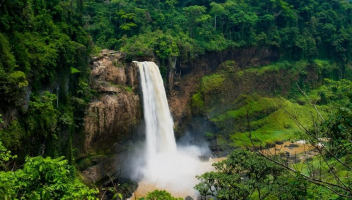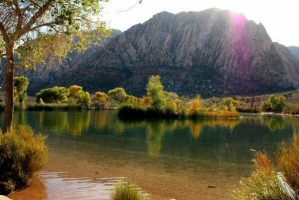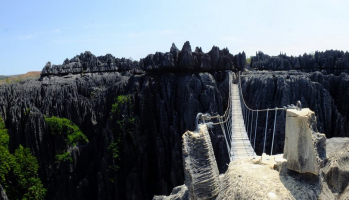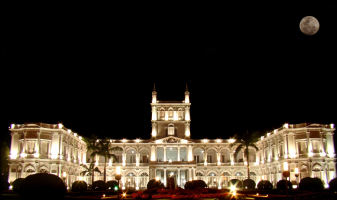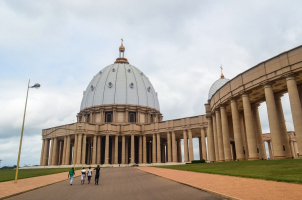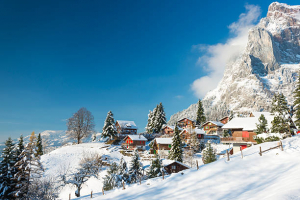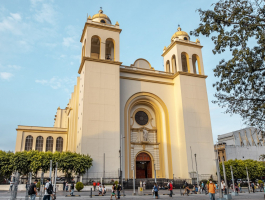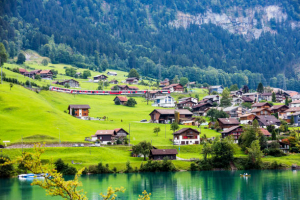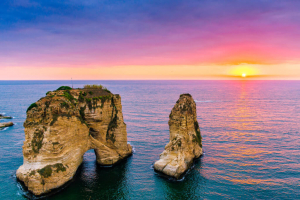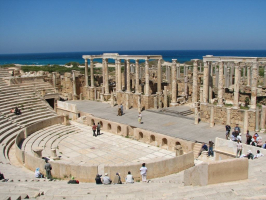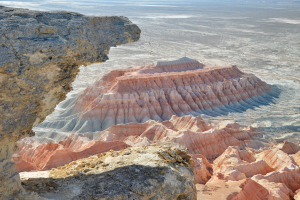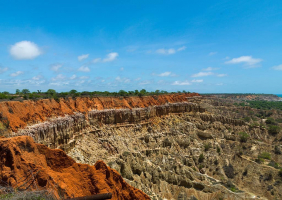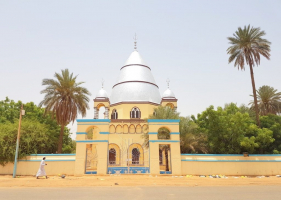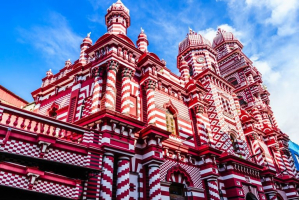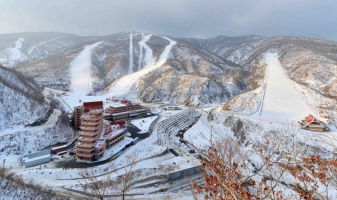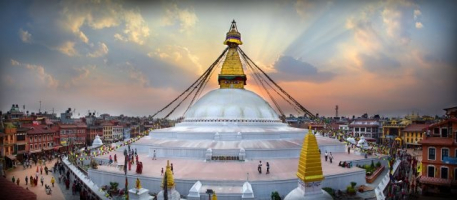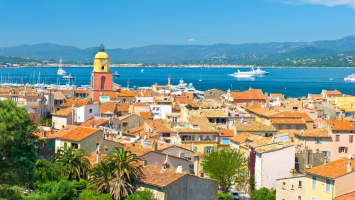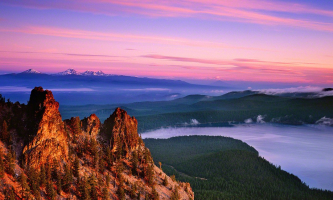Top 15 Best Places to Visit in Warsaw
Warsaw is a city that never fails to impress people who like traveling. It contains nearly everything under the sun! Warsaw is all about sparkling skylines, ... read more...tall skyscrapers, and bustling streets coexisting with peaceful green lawns and gardens, ancient palaces, and Gothic architecture. Whether you enjoy history, classical music, contemporary art, or fitness, Warsaw has something for you. Here is a list of some best places to visit in Warsaw.
-
Irena Bajerska, a landscape architect, designed the Warsaw University Library roof garden, which opened in 2002. The property is 1 hectare in size and offers stunning views of the Vistula River and Warsaw. The planting has symbolic themes and is lush on a 300-mm layer of soil. Green walls and large wall tepees with mathematical formulas, musical scores, and famous quotations in various alphabets adorn the library building. It's a great example of how publicly accessible greenspace can be created on the roof.
Rooftops have traditionally been the domain of chimney sweeps, superheroes, and Santa, but a visit to the Warsaw University Library (BUW) building will quickly change your mind. The bizarre, oxidized green building is topped off by one of Warsaw's best-kept secrets: a two-level rooftop garden covering an entire hectare, complete with bridges, streams, pathways, sculptures, and plant life. There's even a fishpond (that's probably a duck you've seen doing laps) and a stone fountain tucked among the oak trees and Japanese spires.
The garden and viewing platforms, designed by Irena Bajerska and opened in 2002, provide panoramic views of lower Warsaw, including the river, the Copernicus Centre, and across the river to the PGE National Stadium in Praga. Take a picnic and sit among the groups of students taking a break from studying (or napping) at the library below. If you want to get down on one knee and ooze some serious schmooze, this is easily one of the best places in town.
Google rating: 4.8/5
Address: Dobra 56/66, 00-312 Warszawa, Poland
Phone: +48 22 552 51 78
Website: https://www.buw.uw.edu.pl/o-nas/budynek-i-ogrod/Youtube Channel: Svitlana Vakula 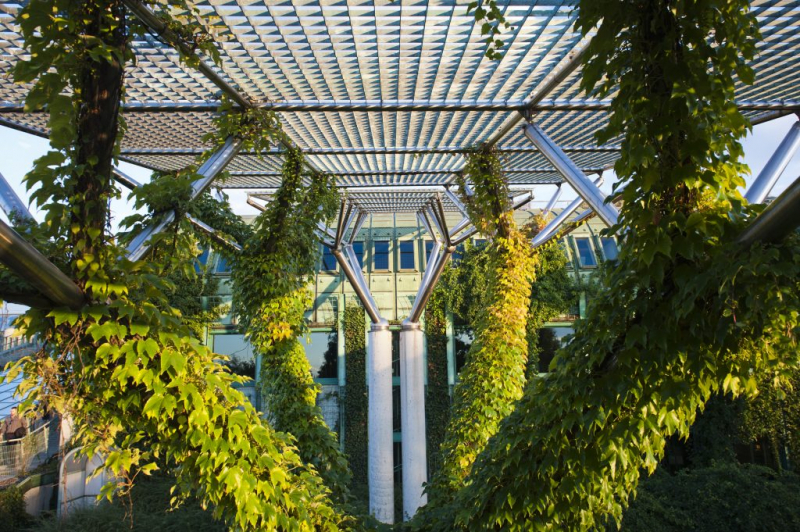
Website Official: https://www.buw.uw.edu.pl/o-nas/budynek-i-ogrod/ -
When it comes to the best places to visit in Warsaw, people can't help but mention Lazienki Park. This vast garden is a favorite spot for Varsovians to take long walks among beautiful nature and architecture to unwind from the city's hustle and bustle. The summer residence of Poland's last king, Stanislaw August Poniatowski, is located in the heart of the park. The complex takes its name from a seventeenth-century bathhouse of a Polish nobleman, which was rebuilt into a palace in the 18th century. King Stanislaw August Poniatowski hosted his famous Thursday dinners here, in the Palace on the Island, where he invited scholars and poets to discuss current issues. It is now a museum where visitors can view paintings from the royal collections.
There is also an orangery, an amphitheater, a court theatre, the Museum of Hunting and Horse-riding, the Mylewicki Palace, and numerous free-standing sculptures on the grounds of aliens. The gardens are full of flowers from spring to late autumn. The park also features squirrels and peacocks, as well as ducks and swans. If you visit Warsaw during the summer, don't miss one of the famous Chopin Concerts, which take place every Sunday from 12.00 and 16.00 from May 15 to September 25. Take a stroll down Chinese Avenue in the winter to see several-meter-long, luminous figures dressed in period costumes.
Google rating: 4.8/5
Address: Warsaw, Poland
Departments: Fountain in Łazienki Park
Phone: +48 504 243 783
Website: https://www.lazienki-krolewskie.pl/plYoutube Channel: CookandEat 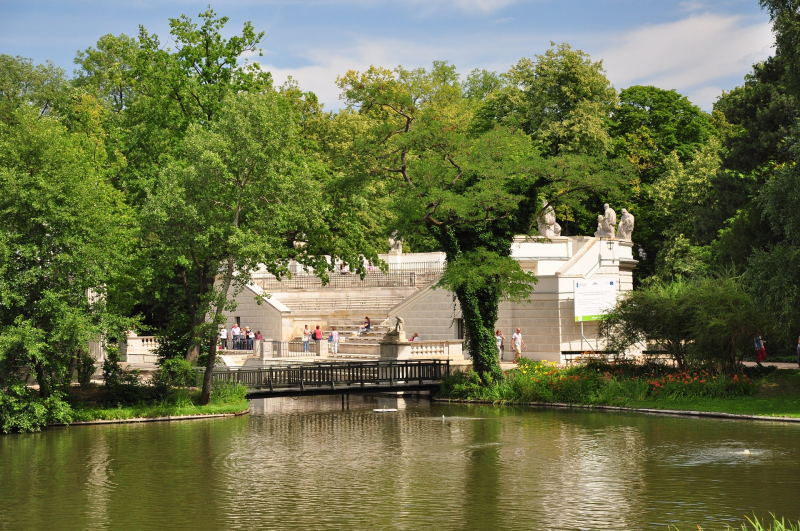
Image by Michał via pixabay.com -
When Saxon Garden off Pisudski Square opened its doors to the public in 1727, it became one of the world's first public parks. It was landscaped in the 17th century for the Saxon Palace, which was destroyed during WWII, as well as the Rococo Brühl Palace, which also backed onto the park. Saxon Garden was originally a Baroque parterre in the style of Versailles, but it has been an English landscape park since the 19th century.
Look for the park's sandstone allegorical sculptures, which were created in the mid-18th century. Twenty of the original 70 remain, and you can try to figure out what each one represents (Intellect, Justice, Astronomy, Painting and Poetry are all pretty easy to decipher). You'd be correct if you think the gardens are missing a palace. The Saxon Palace (Paac Saski), which once stood adjacent to Pisudski Square, was destroyed during WWII, as were many other structures. All that remained were three colonnade arches that have housed the Tomb of the Unknown Soldier since 1925. So far, plans to rebuild Saxon Palace from the ground up at exorbitant cost have fallen through.
Google rating: 4.7/5
Address: Marszałkowska, 00-102 Warszawa, Poland
Hours: Open 24 hours
Created: 1727Website: http://zielona.um.warszawa.pl/tereny-zielone/parki/ogrod-saski
Youtube Channel: TJP To Jest Polska 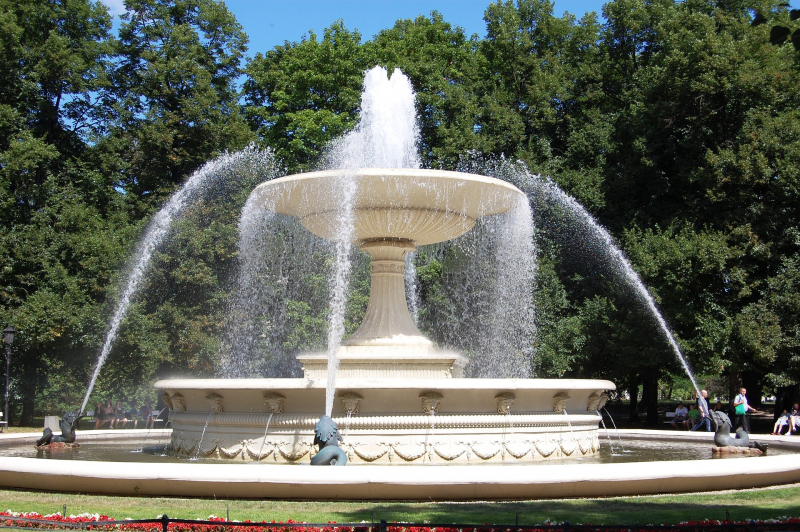
Image by Małgorzata Duszyńska via pixabay.com -
Among the best places to visit in Warsaw, the Uprising Museum is one of them. A one-of-a-kind location that helps visitors understand contemporary Warsaw. This interactive museum commemorates World War II's largest underground combat operation in German-occupied Europe. The 1944 Warsaw Uprising forever altered the face of Poland's capital.
The multimedia exhibition reflects the mood of the Uprising, depicting not only the military history of the 63 days of fighting and civilian life but also the post-war communist terror. While strolling along the granite pavement among the rubble of the destroyed capital, you will hear insurgent stories and see original exhibits from the uprising. In the film City of Ruins, you will understand how soldiers moving through the sewers felt, and you will see a birds-eye view of the flattened city.
You can also take a selfie with a Liberator B-24J replica. Such planes dropped supplies for the troops fighting in Warsaw. At the heart of the museum is a steel monument that runs through all four floors. Its walls are covered with bullet marks and the dates of each day of the uprising, and the sound of a beating heart, symbolizing Warsaw's life in 1944, can be heard from within. Pay attention to the Memorial Wall in Freedom Park, which is adjacent to the museum. It bears the names of nearly 11,000 soldiers killed during the Uprising. Keep an eye out for insurgent murals by well-known Polish artists on the "Wall of Arts."
Google rating: 4.7/5
Address: Grzybowska 79, 00-844 Warszawa, Poland
Phone: +48 22 539 79 05
Website: http://1944.pl/Youtube Channel: Bev and Shams Adventures 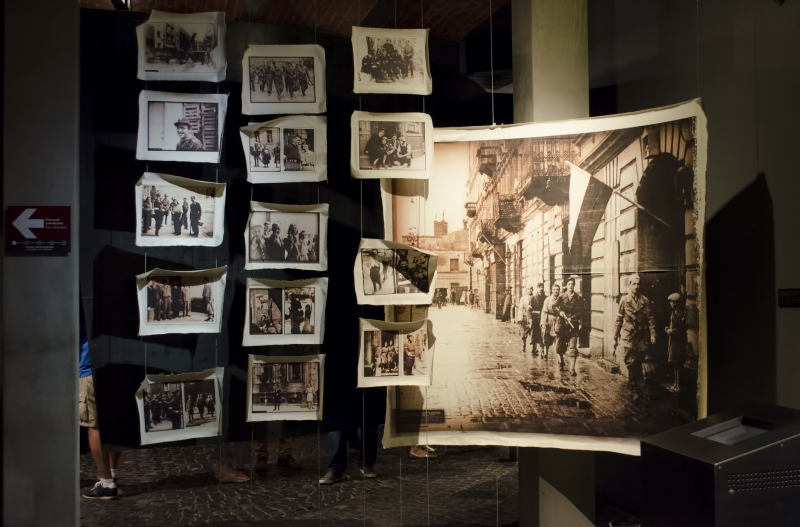
Image by Piotr via pixabay.com -
You enter one of the most important Polish temples by crossing the threshold of this impressive 14th-century structure. The cathedral has witnessed many historical events, including King Stanislaw August Poniatowski's coronation in 1764, as well as royal weddings and funerals. The swearing-in of Europe's first constitution on May 3, 1791, was especially significant. The cathedral was a battleground during the Warsaw Uprising in 1944, and it was blown up afterward. 90% of the structure was destroyed. Following WWII, the temple's original form was rebuilt, restoring the Gothic facade.
In the crypt, you will see the tombs of Mazovian dukes, Warsaw archbishops, the last king of Poland, Stanislaw August Poniatowski, the first Polish president, Gabriel Narutowicz, writer and Nobel Prize winner Henryk Sienkiewicz, and musician and statesman Ignacy Jan Paderewski. The International Organ Festival is held here from July to September.
It has a distinct style and is one of the city's most popular tourist attractions. Take a stroll or ride to St. John's Arch Cathedral and marvel at its stunning architecture. It's easy to see why the cathedral is a popular tourist destination in the city. The cathedral is a sight to behold, with its soaring spires and intricate designs. Beautiful architecture as well as impressive artwork can be found here. Plus, it’s easy to get around, and you are in front of this intergalactic sight.
Google rating: 4.7/5
Address: Świętojańska 8, 00-278 Warszawa, Poland
Phone: +48 22 831 02 89
Website: https://katedra.mkw.pl/Youtube Channel: Polish Soundscapes 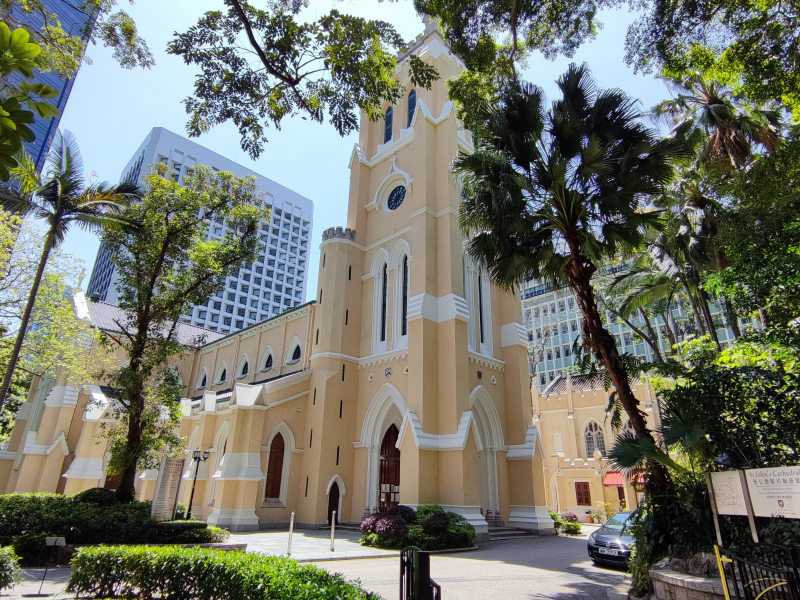
Image by Cheung Yin on unsplash.com -
You will not confuse this building with any other due to its distinctive shape and color. The Royal Castle was the former residence of Poland's rulers. Explore the royal apartments and the throne room on the inside. Pay close attention to original Rembrandt paintings and canvases by Bernardo Bellotto, also known as Canaletto, which were used in the reconstruction of Warsaw after it was destroyed in World War II. See also the Senator's Hall, where the 3rd May Constitution was passed in 1791, the first in Europe and the second in the world.
Enter the beautifully reconstructed gardens at the end: the upper garden on the castle slope and the lower garden at its feet, where the river used to flow in the seventeenth century. It not only complements the residence but is also an ideal place to relax, having been meticulously recreated in the style of the 1920s and 1930s. The expansive lawn, flower beds, fountains, and mazes made of several-meter-high hedges will energize you for more sightseeing. If you have more time, stay a bit longer to see the charm of the garden in the glow of the illuminations after dark.
In winter, in Zamkowy Square, you’ll see an almost thirty-meter Christmas tree, which is a permanent part of the city’s Christmas illuminations. Take an evening stroll through Warsaw's streets to see the illuminations and decorations. This is one of the best places to visit in Warsaw.
Google rating: 4.7/5
Address: plac Zamkowy 4, 00-277 Warszawa, Poland
Phone: +48 22 355 51 70Website: https://www.zamek-krolewski.pl/
Youtube Channel: Brit InPoland 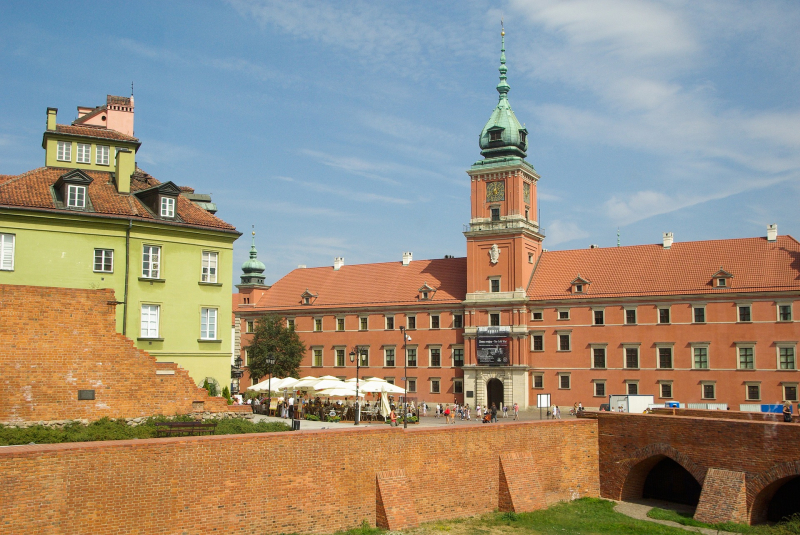
Image by jacqueline macou via pixabay.com -
Warsaw's Old Town is the crowning glory of the Polish capital. Its colorful tenement houses and the unique atmosphere of its narrow streets enchant visitors. It's no surprise that it's on the UNESCO World Heritage List! Make a point of visiting the royal castle. It was there that the 3 May Constitution was ratified, the first in Europe and the second in the world. The royal apartments, paintings by Rembrandt, and canvases by Bernardo Bellotto, also known as Canaletto, can all be found in the former home of Polish rulers.
On Castle Square stands the column of King Sigismund III Vasa, who moved Poland's capital from Krakow to Warsaw in the 16th century. The capital's oldest and highest secular monument is an excellent landmark where locals in Warsaw frequently arrange to meet. The Old Town Square is Warsaw's oldest and one of its most charming squares. This place is impossible not to fall in love with! It was designed around the thirteenth and fourteenth centuries. Celebrations and markets were held here, but convicts were also executed. Despite being over seven centuries old, its shape has hardly changed. A statue of the Warsaw Mermaid, the city's emblem, stands in the center of the square.
If you're interested in the city's history, go to the Museum of Warsaw or take the Old Town Cellars Route. Visit the barbican and the bell on Kanonia street, walk along the old city walls, and photograph the Vistula from the observation point at Gnojna Góra. Enter the cathedral to see the tombs of medieval Mazovian princes, Poland's last king, Stanislaw August Poniatowski, and the great pianist and politician Ignacy Jan Paderewski. The Old Town comes alive in the summer with café gardens and cultural festivals. The Old Town and the Royal Route sparkle with beautiful illuminations in the winter.
Google rating: 4.7/5
Address: Rynek Starego Miasta, 00-272 Warszawa, Poland
Hours: Open 24 hours
Part of: Historic Centre of Warsaw
Website: https://www.wiezacisnien.eu/2022/11/rynek-starego-miasta-w-warszawie.htmlYoutube Channel: Follow Us 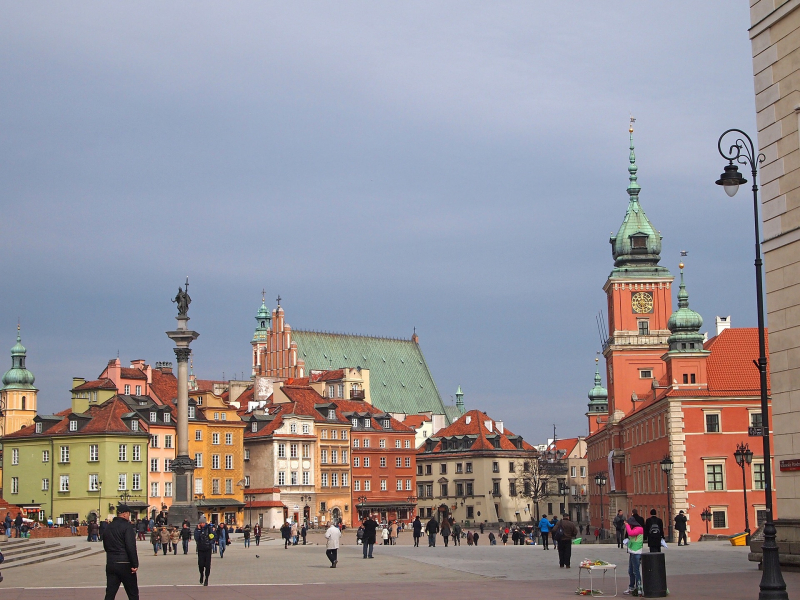
Image by andrzej_b via pixabay.com -
Wilanów Palace is Warsaw's Baroque jewel. Despite annexations, wars, and occupations, the palace and garden remained unaltered. See the residence of King Jan III Sobieski, the vanquisher of the Turks in Vienna, who halted their march through Europe in 1683. The ruler, known as the fearless Lion of Lechistan, resided in the palace with his beloved wife, Maria. The palace houses the king's apartments as well as Queen Maria Kazimiera's suites, which include the Chinese, Dutch, and Antiquities rooms, as well as the Potocki Museum. Stop in the White Room for a moment to see images of other palace owners and people associated with it.
Take note of the lovely seventeenth-century sundial at the back of the palace. It is made up of three shields held by the dignified figure of Saturn and was inspired by the king's astronomical interests. In the summer, stylish sculptures, fountains, charming alleys, a lake, and a cascading stream make the surrounding park an ideal place to unwind from the city's hustle and bustle. Wilanów transforms into a Royal Garden of Light in the winter. Stroll through the gardens, and you'll come across beautiful figures from the distant past, as well as animals and plants with unusual shapes. Thousands of lights illuminate the night, dancing to the rhythm of classical music during special shows. Spend an evening here, and it will stay with you for a long time. The Poster Museum is located nearby, in the former riding hall.
Google rating: 4.6/5
Address: 02-958 Warsaw, Poland
Opened: 1696
Website: https://www.wilanow-palac.pl/Youtube Channel: Skypiece Naids 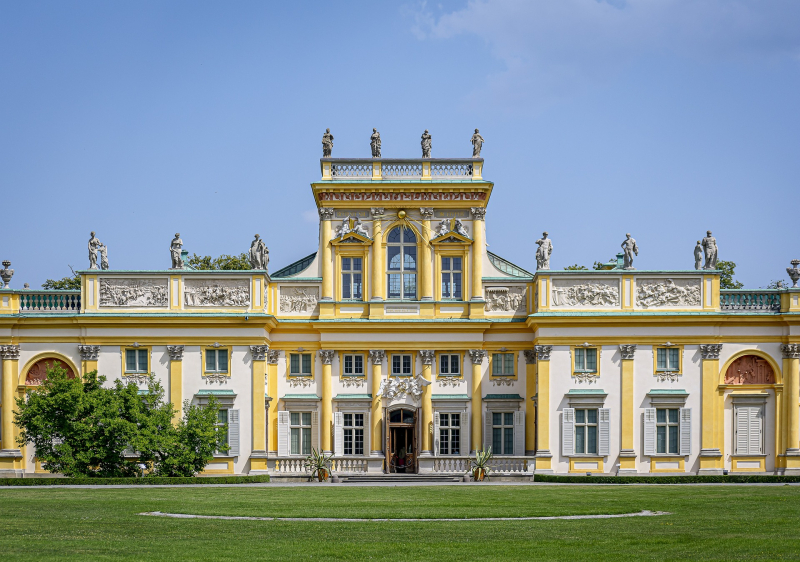
Image by Pawel Grzegorz via pixabay.com -
One of Warsaw's tallest and most recognizable structures can be seen from almost anywhere in the city. What caused it to appear? It opened in 1955 as a "gift of the Soviet people to the Poles" at the initiative of Joseph Stalin. For a long time, it was considered a symbol of socialist power and the pride of People's Poland; it was where conventions of the Polish United Workers' Party were held. Its monumental interiors have hosted numerous concerts, exhibitions, fairs, and shows since its inception.
The palace now houses theaters, a cinema, museums, trendy pubs, and the main tourist information office in Warsaw. Go to the observation deck on the 30th floor of the building to see the beautiful cityscape from 114 meters above the ground. Take a look at the socialist realist sculptures in the palace's facade niches. Each represents a different field of science, art, technology, or culture, such as a young man holding a book of classical literature, a Komsomol member, an archer, or a woman from Central Asia. A stone honor tribune can be found directly across from the main entrance, where the first secretaries of the Central Committee of the Polish Communist Party greeted those marching in the May Day parade.
During the summer, the area around the palace transforms into an arena for a variety of concerts, theater performances, and film screenings. Because of the free ice skating rink, it is a great place for skating enthusiasts in the winter. The structure is beautifully lit at night, and additional decorations illuminate special occasions.
Google rating: 4.6/5
Address: plac Defilad 1, 00-901 Warszawa, Poland
Phone: +48 22 656 76 00
Website: http://www.pkin.pl/Youtube Channel: Charles Huang 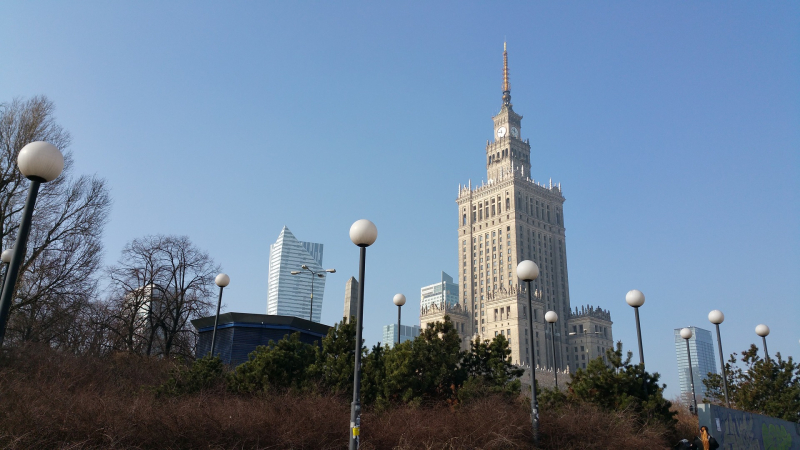
Image by kruszyzna0 via pixabay.com -
You can't miss it if you're walking along the Royal Route. With its two high towers, the monumental baroque church dominates Krakowskie Przedmiecie, and the sculpture of Christ carrying the cross standing in front of the entrance is one of Warsaw's most recognizable sights. Before you go inside, consider the raised hand toward the sky and what it might have meant to Varsovians, along with the inscription "Sursum Corda" (lift up your hearts) when Poland was partitioned or under occupation.
Inside, plaques commemorate ceremonial services, patriotic demonstrations, and the funerals of eminent Polish writers, priests, and political activists who have died there. As you walk past the beautiful sculptures and paintings, remember that aristocrats, kings, and presidents have all prayed here in the past. King Jan III Sobieski prayed there before the victorious expedition to Vienna in 1683, and on May 3, 1792, ceremonies commemorated the adoption of the first European Constitution. Explore the massive gold-decorated main altar, the side chapels, and the location of the outstanding Polish composer Fryderyk Chopin's heart.
Every year on the anniversary of his death, the entire church is filled with the sounds of Mozart's Requiem. If you want to learn more about the history of this extraordinary temple, visit the crypt, which contains the tombs of many people associated with it. Do you know that Witokrzyska Street was named after this church?
Google rating: 4.6/5
Address: Krakowskie Przedmieście 3, 00-047 Warszawa, Poland
Phone: +48 22 826 89 10
Website: http://swkrzyz.pl/Youtube Channel: The Travelbugs 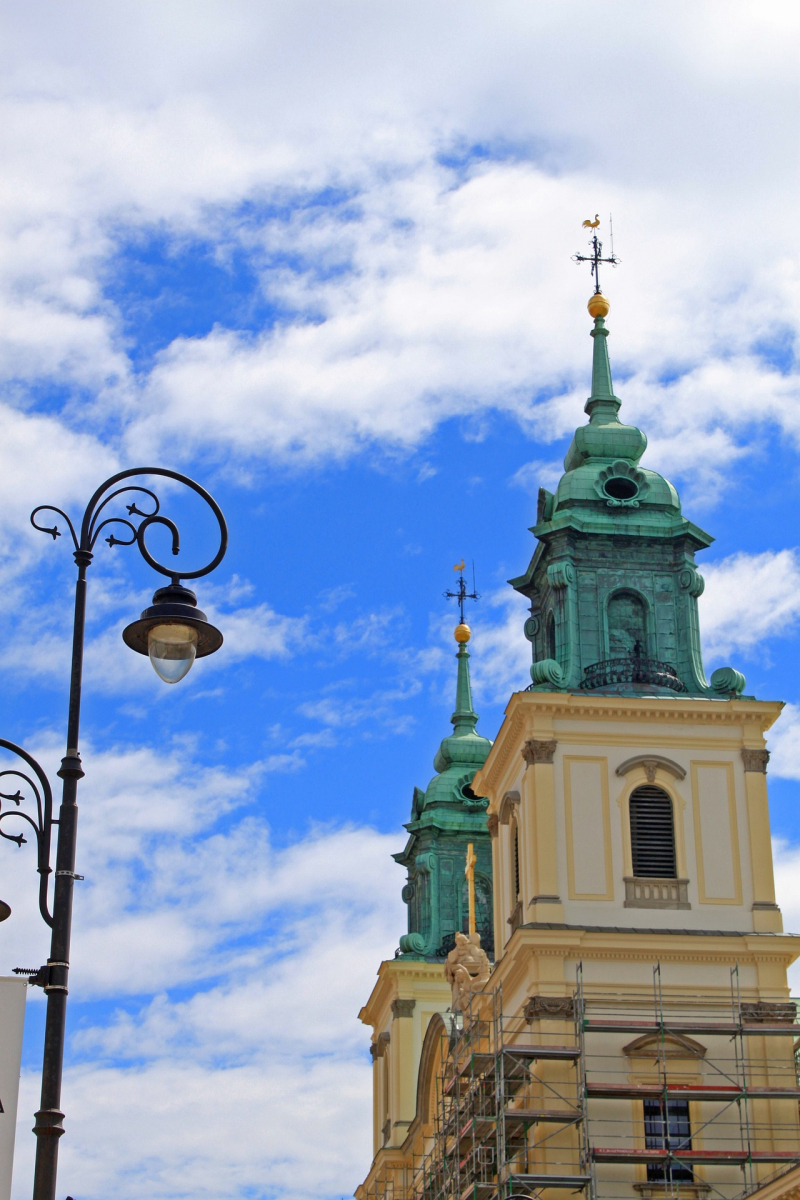
Image by Kate Lukianova via pixabay.com -
Located at the foot of the Old Town, it is a popular spot for residents and tourists to cool off from May to the end of September. Visit on a hot day or in the evening on the weekend to see a spectacular display of light, sound, and water. On the water screen with fog scattered over it, you can watch an animated story about Warsaw's history and legends. It is accompanied by laser lights and several-meter-high water columns that rise to the rhythm of music and are illuminated by colorful floodlights. It is best to sit on the grassy slope to enjoy the spectacle.
Every Friday and Saturday in May, June, and July at 9.30 p.m., August at 9 p.m., and September at 8.30 p.m. In the winter, instead of water, streams of light dance; on weekends, the main fountain transforms into a multicolored animated sculpture, and shows are accompanied by Christmas music. Young children can enjoy the nearby water playground, where they can splash in water gushing directly from the ground on hot summer days.
The park was created for the 125th anniversary of the city’s waterworks, a reminder of this is a bench standing by which is William Heerlein Lindley, the designer of the sewerage network in Warsaw that opened in 1886. This is considered one of the best places to visit in Warsaw
Google rating: 4.6/5
Address: Skwer 1 Dywizji Pancernej WP, 00-221 Warszawa, Poland
Phone: +48 22 849 32 86
Website: http://park-fontann.pl/Youtube Channel: eye view of Poland 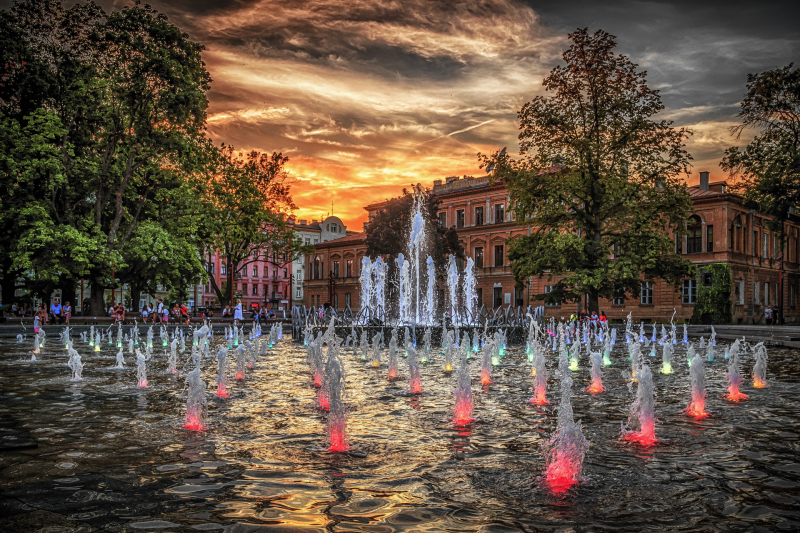
Image by Henryk Niestrój via pixabay.com -
A true paradise for science enthusiasts of all ages! Here you can discover nature's secrets, conduct your own experiments, and have fun while doing so. Do not request a guide at the CSC. Everyone is a researcher and discoverer here, and we never conduct experiments on someone else's orders. You will conduct your own experiments here to discover how your senses allow you to perceive the world.
You will discover how much your body is capable of, as well as its sensitivity to light, color perception, and susceptibility to illusions. Hundreds of exhibits in the Experimental Zone will help you understand wave and current phenomena. At the exhibition, "Future is Today: The Digital Brain?" You will see innovations that will soon be in our homes and learn about the changes that will occur in the near future. You will see if you can trust machines if you can love a robot, and how artificial intelligence "thinks." In addition, you will see a self-driving car and how deep fakery or modern photomontage works.
In the High Voltage Theatre, you can safely electrify yourself to up to 20,000 volts while watching an unusual performance with electrical discharges in the lead role. Check out the Thinkatorium if you like challenges. You can construct a bridge or a flying vehicle if you have the necessary materials. The Robotic Theatre is not to be missed. The humanoids in the play can not only speak and gesticulate, but they can also express their emotions. Visit the Copernicus Science Center's Planetarium to see the incredible shows.
Google rating: 4.6/5
Address: Wybrzeże Kościuszkowskie 20, 00-390 Warszawa, Poland
Phone: +48 22 596 41 00
Website: https://www.kopernik.org.pl/Youtube Channel: Centrum Nauki Kopernik 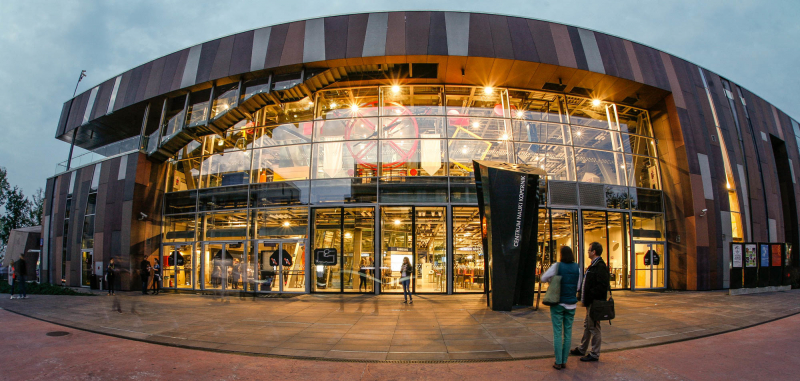
Image by Bianca Fazacas via unsplash.com -
One of Poland's most prestigious and largest contemporary art galleries. It is housed in a lovely historic building designed by Stefan Szyller and built between 1898 and 1900. Zachta has an important collection of Polish postwar art. It has hosted numerous exhibitions of outstanding Polish and foreign artists, including Jan Matejko, Józef Chełmoński, Józef Brandt, Stanisław Wyspiański, Józef Mehoffer, Paul Cezanne, Henri de Toulouse-Lautrec, Pablo Picasso, Max Ernst, Jean Dubuffet, Kim Sooja, Yayoi Kusama, Fernand Léger, and Alina Szapocznikow, Roman Opałka, Mirosław Bałka, Jerzy Nowosielski, Katarzyna Kozyra, Krzysztof Wodiczka and many others.
Zachta is a contemporary art gallery dedicated to showcasing what are arguably the most important phenomena of the twenty-first century. The gallery organizes talks, discussions, and screenings in order to promote living artists from Poland and abroad. The bookshop, which has a great selection of art-related publications, is a must-see for visitors. Zachta also hosts a variety of events such as book promotions, artist meetings, cinema screenings, concerts, readings, and academic conferences. You will never be bored here!
Google rating: 4.6/5
Address: plac Stanisława Małachowskiego 3, 00-916 Warszawa, Poland
Phone: +48 22 556 96 51
Website: https://zacheta.art.pl/plYoutube Channel: Poland Daily Live 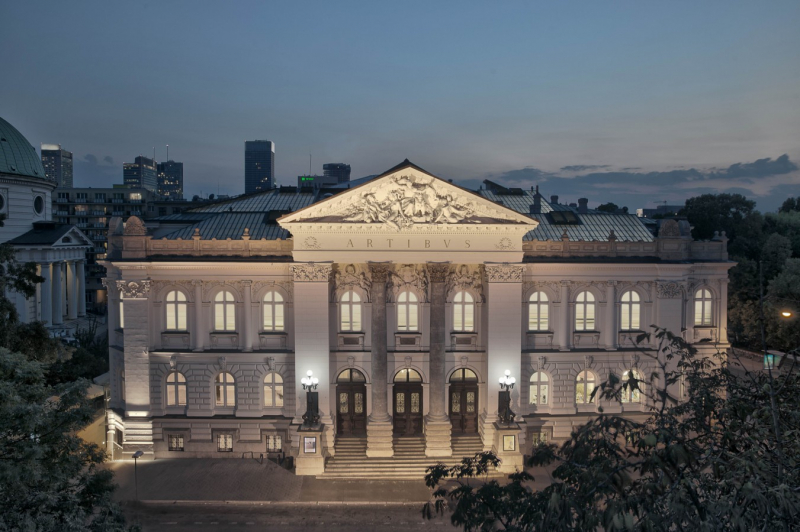
Website Official: https://zacheta.art.pl/pl -
An unusual museum in an unusual setting. One thousand years of history are told in a symbolic location in Warsaw's center: in the pre-war district inhabited primarily by Jews and transformed into a ghetto by the Germans during the war. The museum preserves its rich culture and heritage. Before you begin your tour, pay attention to the building itself, which hides many symbols and meanings. For example, the main hall "cuts" the museum building from the underground to the roof, symbolizing the Holocaust's crack in Polish Jewish history.
The Hebrew word Polin, which means "Poland" or "here you will rest," is written on the glass panes that cover the façades. Then embark on a journey through the centuries, guided by eight theme galleries. Antiques, paintings, interactive exhibits, reconstructions, and video projections will bring this fascinating history to life.
You will discover the traces of the first Jewish settlement in medieval Poland, see the 13th-century royal statute guaranteeing them safety as well as personal and religious freedom, and learn what the "Golden Age of the Culture of Polish Jews" is. One of the museum's main attractions is the reconstructed roof structure of the unique wooden synagogue from Gwodziec, which can be found in the Jewish Town gallery. Following that, you'll walk through a pre-war Jewish street where two cultures collide, then to the World War II Warsaw Ghetto, and finally to the post-war period.
Don't miss the Ghetto Heroes Monument in front of the museum, where German Chancellor Willi Brandt knelt in a historic gesture. This event was viewed as a symbolic apology from Germany for the Holocaust's crimes. A monument to Jan Karski, the emissary of the Polish underground state, is also nearby. In the autumn of 1942, he traveled to the United Kingdom and gave his eyewitness account of the Holocaust to the highest Allied authorities.
Google rating: 4.5/5
Address: Mordechaja Anielewicza 6, 00-157 Warszawa, Poland
Phone: +48 22 471 03 01
Website: https://www.polin.pl/Youtube Channel: Muzeum POLIN 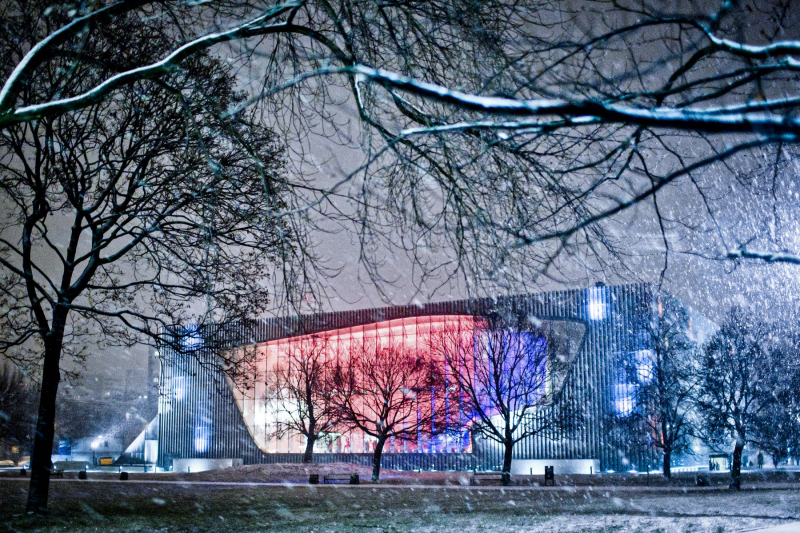
Website Official: https://www.polin.pl/pl -
It is Taiwan's oldest museum of its kind, having opened in 1888. Its collections include exhibits from Polish and international folk cultures. Celebration Time, the largest permanent gallery, features folk costumes and festive clothing from Poland and Europe, as well as paintings, sculptures, Christmas decorations, and props. The "Order of Things" features tools for agricultural work, animal breeding, and other food-gathering activities such as foraging, fishing, and beekeeping. The exhibition "Biblia Pauperum" features the best works from the museum's collection of biblical motifs of salvation found in folk art. Visit the Korean Gallery, which is a recreation of a traditional Korean home. When you walk in, you will feel as if you are in Asia. In addition, the museum also organizes temporary exhibitions.
Powzki Cemetery, the final resting place of some of the country's most important names, is a true treasure, with impressive sculptures ranging from the Neoclassic period and Secession to contemporary art. The catacombs of the cemetery, founded in 1790 by King Stanisaw August Poniatowski, house the remains of the King's family and members of his court. The Aleja Zasuonych (Avenue of Merit), which runs along the southern wall of the catacombs, became a resting place for accomplished Poles, including Nobel Prize-winning writer Wadysaw Reymond and writer Maria Dbrowska, in 1925.
Google rating: 4.4/5
Address: Kredytowa 1, 00-056 Warszawa, Poland
Phone: +48 22 827 76 41Website: http://www.ethnomuseum.pl/
Youtube Channel: Go2Warsaw 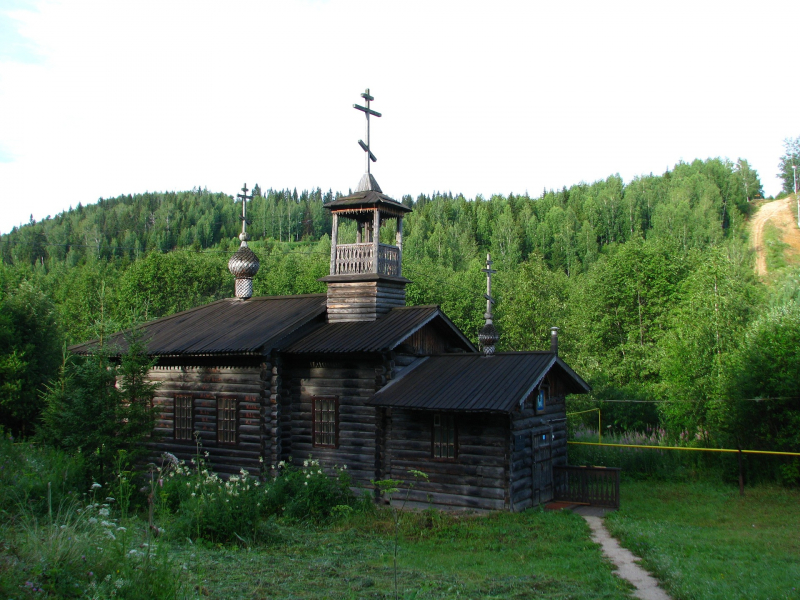
Image by Sergei Berezin via pixabay.com

















